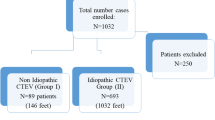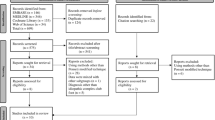Abstract
Background
Congenital talipes equinovarus, or clubfoot, is a common pediatric orthopaedic condition of unknown origin. In many clubfoot clinical trials, interventions are assigned to a patient, but response to treatment is assessed separately in each foot. Trials commonly report x patients with y feet where y is greater than x (eg, 35 patients with 56 feet). However, common statistical tests assume that each data point is independent. Although data from unilateral cases of clubfoot are independent, it is unknown if each foot of patients with bilateral clubfeet are correlated.
Questions/purposes
The purpose of this study was to assess the correlation in the feet of patients with bilateral clubfeet by (1) evaluating the degree of severity between lower limbs of each patient with bilateral clubfeet at baseline; (2) determining if right and left feet of each patient responded to intervention in the same way; (3) determining the proportion of bilateral relapse; and (4) determining the proportion of right and left feet which required the same intervention to correct bilateral relapse.
Methods
We performed a chart review of the records of 33 patients with bilateral clubfeet (66 feet). Baseline severity was assessed using the Pirani score. The number of Ponseti serial casts to correct the deformity, the proportion of patients who underwent bilateral Achilles tenotomy, the proportion of bilateral relapse, and the treatment to correct bilateral relapse were examined.
Results
The degree of severity between right (Pirani score mean, 5.2; SD, 0.8) and left (Pirani score mean, 5.2; SD, 0.5) feet for each patient at baseline was highly correlated (r = 0.76, p < 0.001). Response to intervention between lower limbs was highly correlated for the number of Ponseti casts required for initial correction (right mean, 5.2, SD, 1.1; left mean, 5.2, SD, 1.3) (r = 0.89, p < 0.001) and the proportion of patients who underwent bilateral Achilles tenotomy (right, 17/18; left, 16/18) (r = 0.94, p < 0.001). In the nine patients who experienced relapse, eight experienced bilateral involvement. In all cases of bilateral relapse, the right and left foot of each patient required the same intervention to correct the relapse.
Conclusions
In patients with bilateral clubfeet, baseline severity, response to initial Ponseti treatment, Achilles tenotomy, and relapse outcomes were highly correlated in the right and left feet of each patient. Pooling clinical results of patients who present with bilateral clubfeet is statistically inappropriate, since results in two limbs of the same patient do not represent independent observations. These results support analogous work in other specialties suggesting that patients with bilateral presentations should not be analyzed as independent data points.
Level of Evidence
Level IV, therapeutic study. See the Instructions for Authors for a complete description of levels of evidence.


Similar content being viewed by others
References
Barker SL, Macnicol MF. Seasonal distribution of idiopathic congenital talipes equinovarus in Scotland. J Pediatr Orthop B. 2002;11:129–133.
Bryant D, Havey TC, Roberts R, Guyatt G. How many patients? How many limbs? Analysis of patients or limbs in the orthopaedic literature: a systematic review. J Bone Joint Surg Am. 2006;88:41–45.
Burns J, Ouvrier R, Estilow T, Shy R, Laura M, Eichinger K, Muntoni F, Reilly MM, Pareyson D, Acsadi G, Shy ME, Finkel RS. Symmetry of foot alignment and ankle flexibility in paediatric Charcot-Marie-Tooth disease. Clin Biomech (Bristol, Avon). 2012;27:744–747.
Byron-Scott R, Sharpe P, Hasler C, Cundy P, Hirte C, Chan A, Scott H, Baghurst P, Haan E. A South Australian population-based study of congenital talipes equinovarus. Paediatr Perinat Epidemiol. 2005;19:227–237.
Campeau PM, Foulkes WD, Tischkowitz MD. Hereditary breast cancer: new genetic developments, new therapeutic avenues. Hum Genet. 2008;124:31–42.
Chung CS, Nemechek RW, Larsen IJ, Ching GH. Genetic and epidemiological studies of clubfoot in Hawaii: general and medical considerations. Hum Hered. 1969;19:321–342.
Duffy CM, Salazar JJ, Humphreys L, McDowell BC. Surgical versus Ponseti approach for the management of CTEV: a comparative study. J Pediatr Orthop. 2013;33:326–332.
Dyer PJ, Davis N. The role of the Pirani scoring system in the management of club foot by the Ponseti method. J Bone Joint Surg Br. 2006;88:1082–1084.
Ederer F. Shall we count numbers of eyes or numbers of subjects? Arch Ophthalmol. 1973;89:1–2.
Gray K, Pacey V, Gibbons P, Little D, Frost C, Burns J. Interventions for congenital talipes equinovarus (clubfoot). Cochrane Database Syst Rev. 2012;4:008602.
Halanski MA, Davison JE, Huang JC, Walker CG, Walsh SJ, Crawford HA. Ponseti method compared with surgical treatment of clubfoot: a prospective comparison. J Bone Joint Surg Am. 2010;92:270–278.
Harvey N, Daley D, Mudge A, Sims S, Adams R. Reliability of physiotherapists using the Pirani scoring system for clubfoot. Int J Ther Rehabil. 2012;19:439–445.
Menz HB. Two feet, or one person? Problems associated with statistical analysis of paired data in foot and ankle medicine. Foot. 2004;14:2–5.
Pavone V, Bianca S, Grosso G, Pavone P, Mistretta A, Longo MR, Marino S, Sessa G. Congenital talipes equinovarus: an epidemiological study in Sicily. Acta Orthop. 2012;83:294–298.
Ponseti IV, Morcuende J, Mosca V, Pirani S, Dietz F, Herzenberg J, Weinstein S, Penny N, Steenbeek M. Clubfoot: Ponseti Management. 2nd ed. Seattle, WA: Global-HELP Organization; 2005.
Richards BS, Faulks S, Rathjen KE, Karol LA, Johnston CE, Jones SA. A comparison of two nonoperative methods of isolated clubfoot correction: the Ponseti method and the french functional (physiotherapy) method. J Bone Joint Surg Am. 2008;90:2313–2321.
Shaheen S, Jaiballa H, Pirani S. Interobserver reliability in Pirani clubfoot severity scoring between a paediatric orthopaedic surgeon and a physiotherapy assistant. J Pediatr Orthop B. 2012;21:366–368.
Sutton AJ, Muir KR, Jones AC. Two knees or one person: data analysis strategies for paired joints or organs. Ann Rheum Dis. 1997;56:401–402.
Wallander H, Hovelius L, Michaelsson K. Incidence of congenital clubfoot in Sweden. Acta Orthop. 2006;77:847–852.
Zeger S, Liang KY. Longitudinal data analysis for discrete and continuous outcomes. Biometrics. 1986;42:121–130.
Author information
Authors and Affiliations
Corresponding author
Additional information
Each author certifies that he or she, or a member of his or her immediate family, has no funding or commercial associations (eg, consultancies, stock ownership, equity interest, patent/licensing arrangements, etc) that might pose a conflict of interest in connection with the submitted article.
All ICMJE Conflict of Interest Forms for authors and Clinical Orthopaedics and Related Research editors and board members are on file with the publication and can be viewed on request.
Each author certifies that his or her institution approved the human protocol for this investigation, that all investigations were conducted in conformity with ethical principles of research, and that informed consent for participation in the study was obtained.
About this article
Cite this article
Gray, K., Gibbons, P., Little, D. et al. Bilateral Clubfeet Are Highly Correlated: A Cautionary Tale for Researchers. Clin Orthop Relat Res 472, 3517–3522 (2014). https://doi.org/10.1007/s11999-014-3776-6
Received:
Accepted:
Published:
Issue Date:
DOI: https://doi.org/10.1007/s11999-014-3776-6




